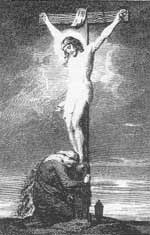Saints of God, make intercession for us
Joan Diehl

Saint Mary Magdalen
July 22nd
"Wherefore I say to thee, her sins, many as they are, shall be forgiven her, because she has loved much . . ."
From the moment of her conversion, St. Mary Magdalen was exceptionally favored by Our Lord. After most of His friends had deserted Him, she stood at the foot of the Cross, assisted at His burial, and was the first recorded witness of the Resurrection. Only the Blessed Mother would have seen her Son first, although the New Testament does not mention such an appearance.
In Sons of the Church, René Bazin describes this beautiful woman who acquired the name of Magdalen "from her property in the pleasure-loving city of Magdala."
"Rich, graceful, sought after, frequenting the lax court of Herod Antipas, she found lovers, and threw public opinion to the winds. Associating herself with
How did such a woman ever come to know Jesus? Like so many others she went, out of curiosity, to see and hear Him one day. She did not yet realize that it was God's grace drawing her to Him. The words she heard that day were meant especially for her. St. Vincent Ferrer says, "...At once Magdalen is stirred to the depths of her soul. Her head sinks beneath the weight of shame and repentance. Tears pour down her cheeks. Her heart is conquered." The seven devils had been cast out but there was not yet peace. Although she knew she was unworthy, she had to see Jesus again and be assured of His forgiveness.
She was afraid to approach Him but her now pure and perfected love drove her to make a bold public repentance. What a tremendous flow of grace had to be surging through this woman of shameful reputation that she could expose herself to contempt by coming openly to Jesus. Our Lord had accepted an invitation to dine with a certain Pharisee called Simon, and the house was overflowing with highly respected guests. Mary Magdalen dared not approach Jesus face to face, but she made her way, unnoticed, through the gathering. Coming up behind Him, she suddenly attracted attention. What on earth was she doing? With her tears, she began to wash the Saviour's feet; with her hair, she dried, then respectfully kissed them. Lastly, she anointed them with her costly perfume.
In Butler's Lives of the Saints, the symbolism of this act is expressed with beautiful poignancy: "She now defaces or consecrates to penance whatever had formerly been an instrument of sin; her eyes, which had been full of dangerous charms, are now converted into fountains of tears to cleanse the stains of her soul; and her hair, once dressed in tresses and curls to ensnare souls, now hangs loose and dishevelled, and serves for a towel to wipe Our Lord's feet, which she kisses with her lips and scents with her perfumes, formerly the incentives of vice."
Thus, St. Mary Magdalen began her new life, leaving forever her past in Magdala, on the west shore of
Shortly before the Passover, Magdalen, divining that Jesus was soon to die, desired to offer Him a most precious ointment. She did so, according to the text of St. Matthew, by pouring it on His head. Some of the disciples complained that she was being wasteful, that the ointment could have been sold for the benefit of the poor. "But Jesus perceiving it, said to them, 'Why do you trouble the woman? She has done me a good turn. For the poor you have always with you, but you do not always have me. For in pouring this ointment on my body, she has done it for my burial. Amen I say to you, wherever in the whole world this gospel is preached, this also that she has done shall be told in memory of her'" (Matthew 26:10-13).
St. Mary Magdalen remained as close as possible to Jesus throughout His Passion and Death, only leaving the sepulchre in order to obey the Commandment of the Sabbath.
In the accounts relating to Our Lord's Resurrection, one of the most thrilling passages anticipates the moment of Magdalen's recognition of Him. "Jesus said to her, Woman, why art thou weeping? Whom dost thou seek? She, thinking that he was the gardener, said to him, Sir, if thou hast removed him, tell where thou hast laid him and I will take him away. Jesus said to her, Mary! Turning, she said to him, Rabboni!" (John 20:15-16).
Following Pentecost and the early days of persecution of the infant Church, the faithful were scattered. According to French tradition, St. Mary Magdalen, along with her family and others, were driven out and put to sea by the Jews. It was approximately A.D. 42 when they landed on the shores of Provence. Magdalen was instrumental in converting the people of Marseilles where Lazarus became the first bishop. She then followed St. Maximin to Aix, where he became bishop. Magdalen retired to a cell where she
Rev. P. M. Sicard, Doctor of Theology, describes
When the day of her death approached, Magdalen had the angels carry her to Aix and the oratory of St.
According to the Catholic Encyclopedia, her body
A few miles from St. Maximin's, towards Marseilles is the solitary Dominican convent of La Sainte-Baume where pilgrims pay homage to the glorious Model of Penitents.
—Joan Diehl
